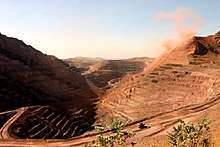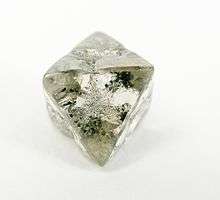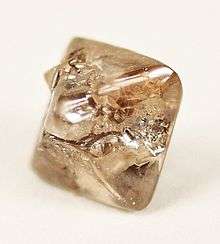Argyle diamond mine
The Argyle Diamond Mine is a diamond mine located in the East Kimberley region in the remote north of Western Australia. Argyle is the fourth-largest diamond producer in the world by volume, although due to the low proportion of gem-quality diamonds it is set to close by 2020. It is the only known significant source of pink and red diamonds, producing over 90% of the world's supply. It additionally provides a large proportion of other naturally coloured diamonds, including champagne, cognac and rare blue diamonds. On June 21, 2015, after more than 11 years and 42 kilometres of tunnelling, the Argyle underground block cave development was officially completed. In 2013, Argyle is estimated to produce 10.2 million carats with an average per carat price of $25/carat.[1]
 The open pit of the Argyle diamond mine. A large mining truck is visible on the road for scale. | |
| Location | |
|---|---|
 Argyle diamond mine Location in Australia | |
| Location | Lake Argyle |
| State | Western Australia |
| Country | Australia |
| Coordinates | 16°42′44″S 128°23′51″E |
| Production | |
| Products | Diamonds |
| History | |
| Opened | 1985 |
| Owner | |
| Company | Rio Tinto Group |
| Website | www.argylediamonds.com.au |

The Argyle diamond mine is also notable for being the first successful commercial diamond mine exploiting a volcanic pipe of lamproite, rather than the more usual kimberlite pipe; much earlier attempts to mine diamonds from a lamproite pipe in Arkansas, USA were commercially unsuccessful. The Argyle mine is owned by the Rio Tinto Group, a diversified mining company which also owns the Diavik Diamond Mine in Canada and the Murowa Diamond Mine in Zimbabwe.
Description
The mine site covers about 50 ha (124 acres),[2] stretching in a mostly linear shape about 1600 m (5,200 ft) long and 150 to 600 m (500 to 2,000 ft) wide. The mine is of open pit construction, and reaches about 600 m (1,900 ft) deep at its deepest point. The open cut closed in 2010.
An underground block cave mine is currently under development, and is likely to extend Argyle's diamond production until 2018.[3]
Location
The Argyle diamond mine is located in the Kimberley region in the far northeast of the Australian state of Western Australia.[4] It is located to the southwest of Lake Argyle in the Matsu Ranges, about 550 km (340 mi) southwest of Darwin. Because it is 185 km (115 mi) by road from the nearest settlement (Kununurra), a complete residential camp has been constructed on site. Most of the 520 workers commute from Perth, over 2,000 km (1,200 mi) away, for alternating two-week shifts at the mine. The mine has encouraged local employment and has a large number of indigenous local people working within the mine.
History
Small quantities of alluvially deposited diamonds have been known in Australia since the late 19th century, first found by prospectors searching for gold. However, no source volcanic pipe deposit was apparent. A systematic search of Western Australia for the source of these diamonds began in 1969. Tanganyika Holdings had employed Maureen Muggeridge and formed a joint venture called Ashton Joint Venture, after minerals which indicated the presence of diamonds were found in 1976.[5] In 1979, Muggeridge discovered diamond samples in the floodplain of a small creek that flowed in Lake Argyle. She soon traced the source of the diamonds to the headwaters of Smoke Creek.[5] On 2 October 1979, the Argyle pipe was discovered.
Over the following three years, the deposit was assessed for economic viability, and in 1983 the decision was made to commence mining operations. Alluvial mining operations commenced immediately, while the open pit mine was constructed over a period of 18 months at a cost of A$450 million. The mine was commissioned in December 1985.
Geology
The mine is the first successful commercial diamond mine (except alluvial mining operations) not located on a kimberlite pipe. The pipe is named "AK-1", although it is commonly simply called the "Argyle pipe".
The volcanic pipe is a diatreme, composed of olivine lamproite, present as tuff and lava. Peripheral volcanic facies suggest the lamproite eruption formed a maar. At the margins of the volcanic pipe the lamproite is mixed with a volcanic breccia containing shattered wall rock fragments mixed and milled by the eruption. Minerals in the marginal facies include zeolite minerals, micas, kaolinite and clays, typical of post-eruption hydrothermal circulation.
Diamonds are found within the intact core of the volcanic pipe, as well as within some of the marginal breccia facies and maar facies. However, some diamonds are considered to have been resorbed during the post-eruption cooling of the pipe and converted to graphite.
The diatreme pipe formed by explosive eruption of the lamproite magma through a zone of weakness in the continental crust.
The diamonds found at the Argyle pipe have been dated to about 1.58 billion years of age, while the volcano which created the pipe is aged between 1.1 and 1.2 billion years old. This represents a relatively short period during which diamond formation could have taken place (around 400 million years), which may explain the small average size and unusual physical characteristics of Argyle diamonds. Diamonds found in the Argyle pipe are predominantly eclogitic, meaning that the carbon is of organic origin (see Natural history of diamonds).
In addition to the pipe itself, a number of semipermanent streams have eroded away portions of the pipe and created significant alluvial deposits of diamonds. These deposits are also actively mined.
Production

Argyle is the fourth-largest diamond producing mine in the world by volume, averaging annual production of 8 million carats (1,600 kg).[6] Production peaked in 1994, when 42 million carats (8,400 kg) were produced. Since operations began in 1983, Argyle's open pit mine has produced over 750,000,000 carats (150,000 kg) of rough diamonds.
Most of Argyle's gem-quality production is in brown diamonds. These diamonds are usually difficult to sell, although Rio Tinto has seen some success in a decade-long marketing campaign to promote brown diamonds as champagne and cognac toned. In contrast, the company has no problems selling diamonds in pink, purple, and red tones, which are very rare and in high demand, therefore commanding premium prices. The pink diamonds are processed and sold as polished diamonds by a specialised team based in Perth to customers worldwide.
The mine has ore processing and diamond sorting facilities on site. Once diamonds are removed from the ore and acid washed, they are sorted and shipped to Perth for further sorting and sale. A significant quantity of diamonds are cut in India, where low costs of labour allow small diamonds to be cut for a profit; this is especially relevant to the Argyle mine, which on average produces smaller rough diamonds than other mines do.
Diamond characteristics

The diamonds produced at the Argyle diamond mine are of an average low quality. Only 5% of mined diamonds are of gem quality, compared to a worldwide average of 20% (Author Janine Roberts contends that the "near-gem" quality rating is subjective and misleading because these diamonds can be cut into gems if desired.[7]); of the remaining 95%, they are about evenly split between classifications of "near gem quality" and industrial grade; 80% of Argyle diamonds are brown, followed by 16% yellow, 2% white, 2% grey, and less than 1% pink and green. Despite the low production volume of pink and red diamonds, the Argyle mine is the only reliable source in the world, producing 90 to 95% of all pink and red diamonds.[8] Most Argyle diamonds are classified as type 1a (see material properties of diamond), and have low levels of nitrogen impurities, their colour resulting instead from structural defects of the crystal lattice. Argyle diamonds tend to fluoresce blue or dull green under ultraviolet light, and blue-white under X-ray radiation. The most common inclusion is unconverted graphite, followed by crystalline inclusions of orange garnet, pyroxene, and olivine.
Annual Diamond Tender
Each year, a small collection of the best pink diamonds are offered in an exclusive sale known as the Argyle Pink Diamond Tender. For every 1,000,000 carats (200 kg) of rough pink diamonds produced by the mine, only 1 carat (0.20 g) polished will be offered for sale at the tender.[9] It is an invitation-only event. Access to the collector's edition catalogue and website access in itself is highly sought after.
In March 2009, Argyle announced their first ever tender of rare blue diamonds. The "Once in a Blue Moon" collection was sourced over several years, and comprised a range of precious blue and violet diamonds, which weighed in total 287 carats (57.4 g).[10]
In 2016, the annual Argyle Tender became the highest selling tender in its 20-year history, according to the Diamond Investment & Intelligence Center.[11]
Reserves
Initial proven reserves of the Argyle mine were 61 million tonnes of ore, with an average ore grade of 6.8 carats (1.36 g) per ore tonne, about 400 million carats (80,000 kg). Further estimated reserves of 14 million tonnes of ore, at a grade of 6.1 carats (1.22 g) per tonne (85 million carats, 17,000 kg), also existed. As of 2001, reserves and resources in the open-pit mined area contain 220 million tonnes of 2.5 to 3.0 carat (500 to 600 mg) per tonne graded ore, sufficient to sustain current production rates until 2007. The ore grades at the Argyle mine are unusually high, with most commercial diamond mines averaging grades of 0.3 to 1.0 carats (60 to 200 mg) per metric ton. Alluvial deposits of diamonds are believed to have been exhausted.
In 1989-1990, drill samples were taken from over 300 m below the floor of the pit. At the end of 1989 around 238 million tons of ore, with an estimated grade of 3.7 carats per ton were quoted as a resource. Much of this resource was below the open-pit and was the subject of an underground mining study carried out in the mid 1990s.
In the late 1990s, part of the west wall of the open pit mine, containing 25 million tonnes of waste rock, began to collapse. In 1998, the decision was made to remove or "cut back" the unstable part of the west wall which freed up further economic ore in the south part of the open pit. This cut back cost around $100 million.
Argyle has just announced on March 2, 2018 that it's estimated Ore Reserves decreased by 13 Million tonnes to just 16Mt. They mined 5Mt in 2017. A more conservative view on future production performance and grades could bring forward the economic shut-off criteria.
An exploration decline was constructed at a cost of A$70 million to evaluate the economics of mining diamonds from the diamondiferous pipes below the floor of the open pit; these reserves would be mined underground (by block caving), rather than the open pit method currently used. In late 2005, Rio Tinto Ltd concluded that the operation was economically feasible. Pre-production construction of the underground mine commenced in early to mid 2006.
Economics
The Argyle diamond mine is economically feasible because its large reserves and high-grade ore offset a low average diamond value. The estimated value of Argyle diamond production is only US$7 per carat ($35/g); this compares to values of $70 per carat ($350/g) for diamonds produced at the Diavik mine and US$170 per carat ($850/g) at the Ekati mine, both in Canada. However, Argyle has two to four times the concentration of diamonds (ore grade) of these mines. This makes extraction economically feasible, as mine costs are mostly related to the amount of ore processed, not the amount of diamond extracted.
Underground expansion
In 2005, Rio Tinto was given the go-ahead to a future expansion project, moving it from an open pit to an underground mine.[12] This plan was postponed; in September 2010 Rio Tinto announced fresh plans to develop an underground mine beneath the existing pit, increasing annual production to 9 million tonnes of ore.[13]
The project is predominantly an underground construction requiring high-quality development and engineering excellence. The Block Cave is expected to operate until the end of 2020[14] using the latest in mining technology, including Sandvik's auto mining technology. The project is due to be completed by 2013, two years later than first planned, after diamond prices slumped.
References
Citations
- Zimnisky, Paul (20 August 2013). "Ranking Of The World's Diamond Mines By Estimated 2013 Production". Kitco.
- Shigley, James E.; Chapman, John; Ellison, Robyn K. (2001). "Discovery and Mining of the Argyle Diamond Deposit, Australia". gia.edu. Gems & Gemology. Gemological Institute of America. 37 (1): 31. Archived from the original on 25 July 2013. Retrieved 7 February 2017.
When found, the AK1 pipe had a surface area of about 50 hectares (~125 acres).
- "Diamonds Annual Review 2008" (PDF). Archived from the original (PDF) on 24 July 2011. Retrieved 22 October 2009.
- Short description of Argyle Diamonds at LJWest Diamonds
- "Geologist left no stone unturned in quest for glittering prize". The Sydney Morning Herald. Fairfax Media. 26 November 2010. Retrieved 14 July 2011.
- Zimnisky, Paul (22 January 2013). "The state of 2013 global rough diamond supply". Resource Investor. Archived from the original on 28 January 2013. Retrieved 4 February 2013.
- Janine P. Roberts (2003). Glitter & greed: the secret world of the diamond empire. The Disinformation Company. p. 243. ISBN 978-0-9713942-9-2.
- "Rare Fancy Pink Diamonds Guide – Price, Color, History | DE". www.diamondenvy.com. Retrieved 9 December 2015.
- "The Argyle Pink Diamonds Tender". Archived from the original on 12 May 2009. Retrieved 24 October 2009.
- "Rio Tinto's Blue Diamond Tender Exceeds Expectations". Retrieved 22 October 2009.
- "Argyle 2016 Diamond Tender Breaks Price Records". Retrieved 6 February 2017.
- More block cave diamonds at Infomine
- "Rio Tinto project expansions roll on with diamonds". Reuters. 14 September 2010. Retrieved 14 July 2011.
- "The Argyle Mine's Closure To Disrupt The Global Diamond Market | IBISWorld Industry Insider". www.ibisworld.com. Retrieved 19 September 2019.
General sources
- Chapman, John; et al. (1996). "The typical gemmological characteristics of Argyle Diamonds". Australian Gemmologist. 19 (8): 339–346. Archived from the original on 19 July 2010.
- "The Argyle Mine and Its Diamonds". The Gemmological Association of Australia. 2005. Retrieved 2009-10-24.
- Earth Observatory, NASA (2002). "New Images: Argyle Diamond Mine, Australia". Retrieved 2009-10-24.
- Shigley, James E; Chapman, John; Ellison, Robyn K. "Discovery and Mining of the Argyle Diamond Deposit, Australia" (PDF). Gems & Gemology. 37 (1): 26–41. doi:10.5741/GEMS.37.1.26. Archived from the original (PDF) on 30 September 2009. Retrieved 24 October 2009.
- "Argyle Diamond Pipe, Western Australia". VolcanoWorld. Retrieved 2009-10-24.
External links
| Wikimedia Commons has media related to Argyle Mine diamonds. |
- Argyle Minesite on Infomine
- Argyle Pink Diamonds
- Rio Tinto Diamonds
- "Discovery and Mining of the Argyle Diamond Deposit, Australia", Shigley, Chapman, and Ellison, Gems & Gemology, Spring 2001